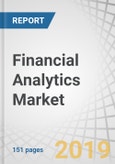Growing digitalization trend, beyond M2M process automation, to drive the financial analytics market
Need of real-time recognition of suspicious activities to safeguard confidential information to drive the adoption of financial analytics in fraud detection and prevention
Fraud attempts have seen a drastic increase in recent times; thus, making fraud detection and prevention more important and applicable across major industries, including BFSI, manufacturing and automotive, retail and ecommerce, telecom and IT, transportation and logistics, healthcare and pharma, energy and utilities, government, education, and real estate. Fraud detection through its real time, near real time, and batch analysis of all its users’ activities, assist companies to safeguard customer and enterprise information, assets, accounts, and transactions. For fraud detection and prevention, financial analytics tools analyze customer data for missing information and provides a holistic view of suspicious transactions. It also screens clients across payment channels, such as wire transfers, checks, fund transfers, deposits, and withdrawals for identifying outliers that might indicate fraud patterns. Data mining technologies such as decision trees, machine learning, AI, cluster analysis, and neural networks are used to generate predictive model for understanding any fraudulent activities across the network.
Enormous data generation and need for interactive analysis to drive the market in Europe
The European region includes both developed and developing economies. Presently, the SMEs in the UK, Germany, and France are investing in analytics platforms to leverage benefits, and in turn, reduce unwanted costs. As the period of economic turmoil continues in Europe, enterprises are likely to undertake a stronger cost containment stance sooner. Europe is the second-largest regional market in terms of market share for financial analytics, but the growth is expected to decline in the coming years. The primary reason for the lesser growth rate in this region could be the Eurozone crisis. Post-Eurozone crisis, business firms are hesitant to make big investments. The factor is not the inefficiency of the business firms, but the skeptical outlook regarding the ROI. Structural deficiencies, overcapacity, low interest rates, and absence of a pan-European banking regulatory agency further paves way for financial analytics tools in BFSI sector.
In-depth interviews were conducted with the Chief Executive Officers (CEOs), marketing directors, other innovation and technology directors, and executives from various key organizations operating in the financial analytics market.
- By Company: Tier 1: 20%, Tier 2: 55%, and Tier 3: 25%
- By Designation: C-Level: 50%, Director Level: 25%, and Others: 25%
- By Region: North America: 60%, Europe: 20%, APAC: 10%, and RoW: 10%
The major vendors offering financial analytics globally include Oracle (US), IBM (US), Teradata (US), TIBCO Software (US), SAP (Germany), SAS Institute (US), Alteryx (US), Qlik (US), FICO (US), GoodData (US), Birst (US), Google (US), Information Builders (US), Zoho Corporation (US), and Domo (US). The study includes in-depth competitive analysis of these key players in the financial analytics market with their company profiles, recent developments, and key market strategies.
Research coverage
The financial analytics market revenue is primarily classified into revenues from solutions, services, or platforms. The revenue associated with solutions and platform offerings is associated with professional, and managed services. Other segments are application, deployment model, organization size, industry vertical, and region.
Key benefits of the report
The report would help the market leaders/new entrants in this market with the information on the closest approximations of the revenue numbers for the overall financial analytics market and the subsegments. This report would help stakeholders understand the competitive landscape and gain insights to better position their businesses and plan suitable go-to-market strategies. The report also helps stakeholders understand the pulse of the market and provides them with the information on the key market drivers, restraints, challenges, and opportunities.
Table of Contents
Samples

LOADING...
Companies Mentioned
- Alteryx
- Birst
- Domo
- Fair Isaac Corporation (FICO)
- Gooddata
- IBM
- Information Builders
- Oracle
- Qlik
- SAP
- SAS Institute
- Teradata
- Tibco Software
- Zoho Corporation
Table Information
| Report Attribute | Details |
|---|---|
| No. of Pages | 151 |
| Published | April 2019 |
| Forecast Period | 2018 - 2023 |
| Estimated Market Value ( USD | $ 6.9 billion |
| Forecasted Market Value ( USD | $ 11.4 billion |
| Compound Annual Growth Rate | 10.6% |
| Regions Covered | Global |
| No. of Companies Mentioned | 15 |









